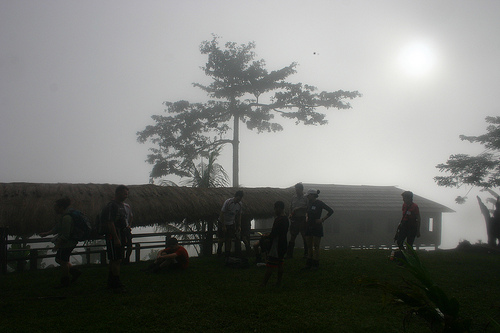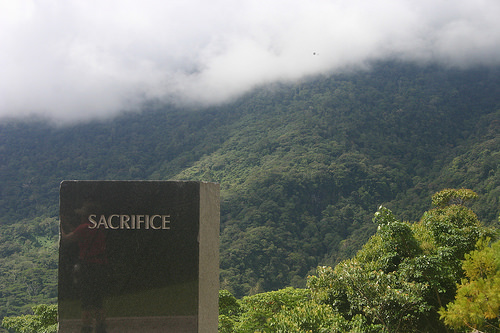The Kokoda Track is a great example of how a historic route can be meaningful for people today. Site of a decisive jungle campaign in the Pacific War, it is a place for both commemoration and personal challenge today.

Every year several thousand people travel to Papua-New Guinea to walk a jungle track across the mountains of the Owen Stanley Range. The Kokoda Track takes them from Owers Corner to Kokoda. The mud path is 96 km long and reaches 2,200 m above sea level. The tropical climate of Papua-New Guinea adds to the difficulty with high temperatures, humidity and regular downpours. Until 2012 even a long distance endurance race was held along the track. However, trekking alone requires training, determination and challenging your own limits.
While adventure travel and endurance sports are generally popular in today’s world and there are similar events around the world, the history of the Kokoda Track adds another dimension to this challenge.
The Kokoda Track Campaign
The track across the Owen Stanley Range became famous for its role during the Second World War, when Papua-New Guinea was controlled by Australia.
In early 1942, Australia was in shock. The Japanese aggression that started with the attack on Pearl Harbour (7.Dec.1941) took them by surprise. Their main forces were engaged against Germany in the Mediterranean. In February, another 15,000 soldiers surrendered in Singapore. Rabaul, the naval base in the Solomon Sea fell and Darwin was bombed. Submarines raided Sydney Harbour in May. The feeling was that an invasion was imminent.
The next target for the Japanese was Papua-New Guinea. The base at Port Moresby would have allowed their bombers to strike on the Australian main land.
The naval assault on Port Moresby was stopped by the Allies in the Battle of the Coral Sea in May 1942.
Japanese forces however landed on the North Shore of Papua-New Guinea near Gona in July and planned to cross the jungles of the Owen Stanley Range and attack Port Moresby by land.
Australian reserve troops fought the Japanese but had to retreat almost to Owers Corner.
The long supply line along the Kokoda Track and the arrival of Australian troops – pulled back from the Middle East – stopped the Japanese advance and the Australians gained the initiative. In November, Kokoda was retaken and in January 1943 the Japanese had to give up the beachheads around Gona.
The Kokoda Track campaign was seen as the battle that saved Australia and together with the Guadalcanal campaign, the turning point of the war in the Pacific.
Supplying troops in the jungle
For most of the campaign, the single file jungle track was the only way to transport supplies to the soldiers fighting in the mountains. Food, ammunition, medicine as well as wounded soldiers on their way back had to be carried by others. Vehicles could only go as far as Owers Corner and pack animals could not survive the climate.
The native people of Papua-New Guinea worked as porters for both armies. The Australians named them fuzzy-wuzzy angels in recognition for their help in carrying many of their wounded soldiers out of the jungle.

Managing the track today
Since the 1990s, Australians become more aware of the importance of the Kokoda campaign for the history of their country.
The route of the mud track today may vary in parts from the days of the war, but walking the Kokoda Track today is still a challenge. It is a challenge in the footsteps of the soldiers who fought in the war and it makes their hardships easier to understand.
It is also a way to commemorate the war. Many of the locations of the campaign are not accessible any other way.
There are remains of the war all along the track. Stashes of ammunition, or weapons collected from the locals, which are on display in their villages. Many of these are in a dangerous state of decay and the Australian Defence Force sent their experts to the Kokoda Track to clear some of the ordnance.
The unsafe ordnance along the track however is only one of today’s problems in managing the track. The small and remote communities along the way are not always prepared to deal with the impact of the tourists and some tourists underestimate the conditions along the track.
To improve safety and sustainability, the Kokoda Track Authority only allows registered tour operators to run tours. They need to show proper training of their guides in areas such as first aid, the size of the tourist groups is limited and emergency communication systems established.
What the Kokoda Track has to offer today
For Australians, the Kokoda Track became a symbol for what their country can achieve through the virtues that are featured in the war memorial at Isurava, high up in the jungle near Kokoda: Courage, Endurance, Mateship and Sacrifice.
The reserve troops that fought off the Japanese invasion along the Kokoda Track showed these virtues and made the track a symbol that resonates with people today.
Then sign up for our free email newsletter to get all our new posts right to your inbox.
